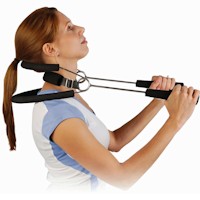Neck Stretches Can Keep Your Neck Flexible And Increase Mobility
Stretches for your neck can help prevent stiffness and can aid in recovery of an injury like whiplash. If you are experiencing significant pain from an injury or pinched nerve, you should do neck stretches under the care of a health care professional.
Neck stretches should feel comfortable and should not produce pain. Stretches should keep joints and muscles moving and flexible as you work to restore full range of motion in the neck. This can be quite simple or more of a challenge for those who have arthritis of the neck or degenerative disc disease and those recovering from neck pain, a sprain or strain from whiplash or other neck injury.
Stretches can decrease neck stiffness, pain and inflammation, as well as help to prevent neck pain. It is important to use some simple stretches, especially if you work at a computer or times when you are maintaining long periods without moving your head.
- A 2012 scientific paper in the journal Work indicates long periods of sustained static positioning with muscle activity that is not interrupted is related to neck and shoulder pain.
The authors note that work or other exposures that contains long periods with uninterrupted neck muscle activity of 4 min duration or longer should be minimized to reduce risk of neck and shoulder pain. The following stretches would be good to do frequently throughout the day as a simple and easy method to help prevent neck pain. Having an ergonomic work station can really make a difference.
 |
Neck Stretch 1 – Flexion/Extension Stretches:
Flexion: Stretching the neck in flexion is slowly letting your head bend forward and holding for 30 seconds. You should feel the stretch in the back of your neck. If you work at a computer or in other areas where you keep your head forward, this may not be the right type of stretches for you to do. Extension: Stretching the neck in extension is allowing you head to bend backward and holding for 30 seconds. If you have any disc problems, pinched nerve or a facet joint syndrome of the neck, do these stretches with caution. |
 |
Neck Stretch 2 – Rotation Stretches:
Turn your head to the right and hold for 30 seconds and then to the left and repeat. You may not be able to do the same amount on each side. Take it slowly and there should be no pain, just a gentle stretching opposite the side your head is turned. Stop if you feel pain in your neck to the side your head is turned or if you experience any radiating symptoms into the arm. |
 |
 |
Neck Stretch 3 – Lateral Flexion Stretches:
Bend your head to the right and hold for 30 seconds and then to the left and repeat. You may not be able to do the same amount on each side. Take it slowly and there should be no pain, just a gentle stretching opposite the side your head is turned. Stop if you feel pain in your neck to the side your head is turned or if you experience any radiating symptoms into the arm. |
 |
- A 2015 study in BioMed Central Musculoskeletal Disorders studies motion of the cervical spine in neck pain patients compared to healthy individuals. The authors of the study indicated patients with neck pain have more rigid and stiff motion. Out of all the individual motion related factors studied, neck flexibility was the only one significantly associated with neck pain. Therefore, these gentle neck stretches are an important part of managing neck pain relief.
- A 2020 study in the Orthopedic Journal of Sports Medicine found that college baseball pitchers that had less preseason neck mobility had an increased risk of shoulder and elbow disability including time loss and during the season.
Remember, these are basic stretches. They are simple to do, however, you must pay attention to any symptoms like pain or dizziness. You can see from the back view illustrated that stretches can effect the joints, so use caution. Increasing mobility is the goal.
It is important that the neck stretches are done correctly. Although simple, it is easy to cheat. If you are bending your head to the right and your left moves with it, this is wrong and is compensation that does not permit a proper stretch. If you can only go a little, just do a little. Sometimes, if you have a herniated disc or pinched nerve, bending or rotating the head to one side will cause pain – do not do this if it reproduces your pain. This is different from a stiff muscle that is OK to stretch within tolerated pain levels. If you are not sure, ask a professional.
When you can do these with no pain, you can progress to a more advanced stretching routine as illustrated by Dr. Mandell.
For those who work at a computer or have a problem with forward head posture or the flexion part of these stretches, I recommend a simple neck lengthening exercise or to get a little more involved with the beginning neck exercises and the neck stretching that follows. These can help with neck pain and to restore function of important postural neck muscles.

 Neck Stabilization
Neck Stabilization Cervical Pillows
Cervical Pillows Neck Support Collars
Neck Support Collars